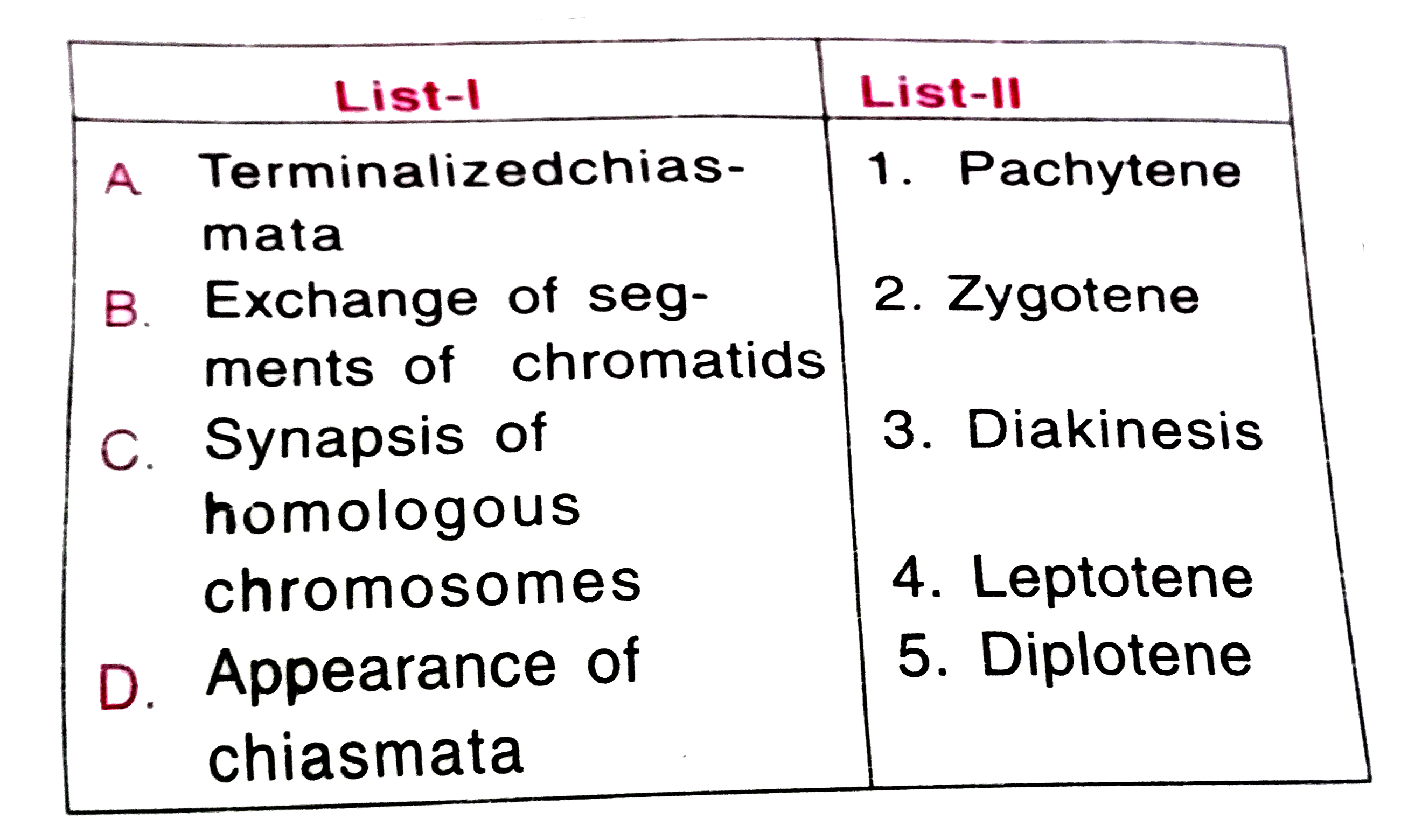(i) Thin thread like chromosomes with a beaded appearance
(ii) Appearance of recombination nodules
(iii) Formation of bivalents/tetrads
(iv) Terminalisation of chiasmata
(v) Appearance of chiasmata
Identify the different stages with respect to the above given features and select the correct option.
The correct Answer is:C
Step by step video, text & image solution for (i) Thin thread like chromosomes with a beaded appearance (ii) Appearance of recombination nodules (iii) Formation of bivalents/tetrads (iv) Terminalisation of chiasmata (v) Appearance of chiasmata Identify the different stages with respect to the above given features and select the correct option. by Biology experts to help you in doubts & scoring excellent marks in Class 11 exams.
Topper's Solved these Questions
Similar Questions
(i) Thin thread like chromosomes with a beaded appearance
(ii) Appearance of recombination nodules
(iii) Formation of bivalents/tetrads
(iv) Terminalisation of chiasmata
(v) Appearance of chiasmata
Arrange the given statemetns in the correct sequence of their occurrence during prophase I.View SolutionIn which phase of meiosis are the following formed ? Choose the answers from hint points given below.
(a) Synaptonemal complex .....
(b) Recombination nodules ....
(c) Appearance/activation of enzyme recombinase....
(d) Termination of chiasmata.... (e) Interkinesis....
(f) formation of dyad of cells....
Hint (a) Zygotene, (b) Pachytene,
(c) Pachytene, (d) Diakinesis,
(e) After Telophase-I/before prophase of meosis-II,
(f) Telophase-I/after meiosis-IView Solution
Knowledge Check
- Question 1 - Select One
Grafting is the union between two plants of closely related varieties. Following are some statements regarding different types of grafting.
(i) An oblique cut followed by a notch is given to both stock and scion.
(ii) Scion is a bud with a small piece of bark and cambium.
(iii) Both stck and scion are of same diameter.
(iv) Stock has many times more diameter than scion.
Identify the type of grafting with respect to these statements and select the correct option.Acan be tongue grafting in which diameter of stck is larger than that of scion.Bcan be bud grafting in which stock of monocot and scion of dicot plant are usually united.Ccan be wedge grafting in which v-shaped notch is given to stock whereas wedge like cut is given to scion.Dcan be crown grafting in which many stcks are inserted in the slits made in the scions. - Question 2 - Select One
Study the following step which are followed during the process of gene therapy while treating a patient of SCID
(i) Retrovirus infects lymphocytes extracted from bone marrow of the patient and cultured
(ii) Engineered cells are injected into patient's bone marrow
(iii) Normal allele is inserted into a retrovirus
(iv) Retrovirus makes a DNA copy of its RNA. This DNA carrying the normal allele gets inserted into the chromosome of the host cell
Arrangement the above given steps in correct sequence and select the correct optionA(iii),(i),(ii),(iv)B(iii),(i),(iv),(ii)C(iv),(ii),(iii),(i)D(iv),(iii),(i),(ii) - Question 3 - Select One
Consider the following steps involved in nodule formation in the root of a legume.
(i). Bacteria release chemicals and enzymes.
(ii). Bacteria stop dividing and form bacteroides.
(iii). Roots secrete chemical atractants.
(iv). Formation of infection thread.
(v). Formation of nodules.
(v). Formation of nodulues.
(vi). Division of infected cortical cells.
(vii) Curlinig of root hair and degradation of their cell wall.
(viii). Infection thread grows along with multiplication of bacteria.
Arrange the steps in the right sequence and mark the correct optionA(iii).(i),(vii),(iv),(viii),(vi),(v),(ii)B(iii),(iv),(viii),(i),(vi),(vii),(ii),(v)C(i),(iv),(iii),(vi),(v),(vii),(viii),(ii)D(i),(iii),(vi),(iv),(viii),(ii),(v),(vii)
The figure given below represents the stage of cell division. Read the following statements.

(i) Nucleolus, Golgi complex and ER reform.
(ii) Chromatids move to the opposite pole.
(iii) The activity of the recombinase enzyme.
(iv) Homologous chromosomes separate while sister chromatids remains associated at their centromere.
(v ) Initiated of the assembly of the mitotic spindle.
How many of the above statements is not true with respect to the above figure-View SolutionMatch List-I (Distinguishing features based on chromosomal appearance) with List-II (Stage of meiosis) and select the correct an swer using the codes given below the list
 View Solution
View SolutionI. Semi-permeable membrane contains network of submacroscopic holes or pores.
II. Semi-permeable membrane appears to be continuous sheets or films.
III. Solvent molecule cannot pass through the holes of semi-permeable membrane but solute molecule can pass.
On the basis of the statements given above select the correct option.View SolutionWhich one is correct about crossing over/ genetic recombination?
I. It occurs in tetrad stage. It occurs in pachytene of prophase I of meiosis I
II. It occurs between non-sister chromatids of homologous chromosomes
III. It is the exchange of gene.tic material between the homologous chromosomes
IV. It is recombinase enzyme mediated process
V. Recombination nodule of synaptonemal complex between the homologous chromosomes is the site of crossing over.
VI. It causes genetic variation which is important for evolution.
VII. It is also the reciprocal transfer of genes between the non homologous chromosomesView SolutionGiven below are some step for slicing foreign DNA into a plasmid and then inserting the plasmid into a bacterium.
(i) Transform bacteria with recombinant
(ii) Cut the plasmid DNA using restriction enzyme .
(iii) Extract plasmid DNA to - DNA fragments DNA
(iv) Bind the plasmid DNA to non-plasmid DNA fragments .
(v) Use ligase to seal plasmid DNA to non- plasmid DNA
Arrange the above steps in the right sequence and select the CORRECT optionView Solution

